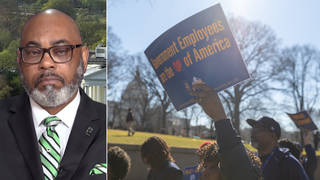
Topics
Critics question how millions of the people could safely leave the metropolitan area if the Indian Point nuclear point was attacked or suffered a meltdown. We host a debate between the plant’s operator and nuclear activists including Harvey Wasserman. [Includes transcript]
Click here to read to full transcript
Last week efforts to shut down the New York nuclear plant Indian Point was dealt a major setback. The Federal Emergency Management Agency endorsed the plant’s emergency evacuation plan. Soon after, the Nuclear Regulatory Commission approved the evacuation plan. This came despite claims by many state, local and federal officials that the evacuation was flawed.
Sen. Hillary Clinton has said she was “deeply disturbed” by FEMA’s decision. She called on FEMA to conduct a new test of the emergency plan for the Indian Point nuclear power plant within six months.
Opponents of the nuclear plant had hoped rejection of the evacuation plan could help lead to the total shutdown of the plant which is located about 35 miles north of midtown Manhattan.
- Harvey Wasserman, senior advisor to the Nuclear Information & Resource Service and author of The Last Energy War (Seven Stories Press).
- Manna Jo Green, Environmental Action Director of Hudson River Sloop Clearwater. This was one of the founding groups of the Indian Point Safe Energy Coalition. The coalition was formed after the September 11 attacks in order to close down the Indian Point nuclear power plant.
- Jim Steets, spokesperson for Entergy Nuclear Northeast.
TRANSCRIPT
AMY GOODMAN:Why don’t we start off with Jim Steets, can you talk about the approval by both FEMA and the nuclear regulatory commission of the evacuation plan?
JIM STREETS: Well, sure, I’ll be glad to. Thanks for having me on the program. The FEMA acts on behalf of the N.R.C. since it has the expertise to determine the adequacy of the emergency response plan. Of course participates in the process that leads to the approval. So every year they go through a whole list of actions that they take to make improvements of the plan and to ensure that it is updated. And so in the January, February timeframe each year the activities are documented and typically are forwarded to FEMA through the state emergency management office and then the FEMA would then looking at that information or gaining information from its own participation in the process can notify or write to the N.R.C. of the state that the emergency response plans in the areas of nuclear power plants are adequate to protect public safety. And just this last week as we’re all well aware, FEMA has done that so this sort of annual ritual was just completed recently. The Indian Point plant for years have had emergency response plan. Every year during that time refines it or makes improvements. Again it’s been acknowledged and ascertained by FEMA that the emergency response plan can adequately protect the public safety.
AMY GOODMAN: Manna Jo Green, what is your concern with this evacuation?
MANNA JO GREEN: Well, I think Jim accurately described it as the ritual. It is a ritual, it’s a token rubber stamping, I don’t think that FEMA and then the N.R.C. have done due diligence. Governor last year hired an independent highly experienced team of people headed up by James Lee Witt and the Witt report clearly indicated that it is impossible to evacuate the area around Indian Point safely. And in our opinion, in Clearwater’s opinion and the opinion of the Indian Point Safe Entergy Coalition and all of the people that are working on this issue. FEMA and the N.R.C. have abrogated their responsibility to the public to protect public health and safety in this recent decision. Clearly for the first time in history all four counties involved refuse to recertify this plan based on the concerns raised by the Witt report and the state emergency management agency also refused to recertify in our opinion this plant is poses a severe danger to the people in the New York metropolitan area in Connecticut and in New Jersey and needs to be closed immediately and decommissioned carefully over time.
AMY GOODMAN: Harvey Wasserman can you put this in a national context?
HARVEY WASSERMAN: Well, the emergency evacuation plans were required by Congress after three mile island, the accident in 1979 in Pennsylvania and the the idea of evacuating any nuclear plant in the face of major melt down is absurd and probably most absurd anywhere in the country at Indian Point. The idea of that incredibly crowded area with the limited highway system is just idea of getting people out of there in an emergency situation with a cloud of radiation being released at Indian Point is just nonsense. It’s utter nonsense. It’s completely irresponsible. It can’t be done and the nuclear plant needs to be shut down. We know that on September 11th the first jet that flew into the world trade center flew directly over Indian Point, had God forbid they decided to drop down a minute early and hit Indian Point, 99% of the people listening to the show would be dead or dying. And the entire New York area would be uninhabitable. As per Chernobyl and or worse, and the idea that these plants should continue to operate is utter nonsense. We have plenty of alternative power to be gotten and this has been going on for a long, long time. We’ve had report at the Perry nuclear plant in Ohio that showed the same same thing that the place can’t be evacuated. Just completely irresponsible and completely money driven by Entergy and the other owners of nuclear plants, complete disregard of the public safety. These reactors are old, they’re increasingly dangerous, they’re being run irresponsibly and the technology is really a technology that whose time never came and to say the plants are obsolete is kind. They just don’t have any justification for continuing to operate they need to be shut immediately. That’s the long and short of it.
AMY GOODMAN: Jim Steets of Entergy, your response.
JIM STREETS: the nonsense he just told you, nobody except the people who have long opposed nuclear power like the two that are on this program with me are making the statements that you’ve heard just now. These plants are safe, they’re secure, they’re extremely important to the region, they’re operated extremely well by Entergy. They are important facilities. Nobody’s making the claims except those who are opposed to Indian Point that New York would be uninhabitable after an accident at the plant. These are not nuclear bombs. These are nuclear power plants that produce electricity, they’re well designed, they’re containment buildings can withstand tremendous impacts. They have multiple cooling systems, they’re responsibly run by a company that is recognized nationally as an expert in operating these plants.
AMY GOODMAN: What about this idea of a plane hitting the Indian point nuclear plant.
JIM STREETS: Well, we were very confident soon after 9/11 after sitting down with our own civil and structural engineers talking about designing these containment build thanks they could withstand planes crashing into them. The industry spent a million dollars studying this very subject, studying the potential impacts of a jet crashing into these containment domes. The fact is that these containment domes are different than any other structures in the world. They are not tall office buildings. They would not permit jet fuel to get inside them and burn and melt the steel that caused the collapse of the world trade center. We’re very confident in the capability of these containment buildings and of course the area wasn’t the only one that we’d consider. We added security enhancements unprecedented security enhancements to an industry that already was the best defended and most secure nonmilitary industrial facility.
AMY GOODMAN: Manna Jo Green, your response.
MANNA JO GREEN: Even if that were all true and there are a lot of question about the security of Indian point and the whole security system that would not apply to the fuel rods that are stored in a relatively unprotected building. So we think that it’s an extremely vulnerable target. Not just to a terrorist attack, but also it has a history of a safety record that is abominable. I want to give Entergy credit, there is has been an effort to try to rectify the backlog of work orders and safety violations. However until recently it was listed as the worst in terms of the number of violations and also the actual internal incidents, the Indian point II was closed for ten months during the year 2001 I believe. And during that time it was closed due to a boiler deficiency in a boiler pipe that actually caused there was a breakage and a release of steam from that accident and the whole plant was shut down for renovation. During that ten month time, Indian point II was out of commission and not supplying electricity to the grid and New Yorkers didn’t know the difference. That’s one of the two plants located at that site.
AMY GOODMAN: Let me ask Jim Steets and issue of the report. James Lee Witt , the former director of FEMA who said that the evacuation plan is inadequate. Did that concern Entergy, FEMA’s own director.
JIM STREETS: It did. Because we poured through that document found no explanation for the conclusion that it drew. It didn’t explain what would occur at the plant that would make the plan inadequate. It came up with decided on a scenario without ever explaining the basis for it.
AMY GOODMAN: Harvey Wasserman, 20 seconds left, comment?
HARVEY WASSERMAN: You can see the basis of it every day at rush hour, we’ve already seen the Shoreham Nuclear Plant on Long Island shut down because of the absurdity of trying to evacuate in the face of an accident. The same or worse in Indian Point. There’s absolutely no way that you can evacuate that area in the face of an accident which could occur for any number of reasons due to all sorts of internal failures which have occurred and other reactors around the world, basically you have a technology that needs to be gone and it has no place today.
AMY GOODMAN: On that note
JIM STREETS: None of which would prevent us from being able to evacuate the area.
AMY GOODMAN: On that note we have to wrap up. Harvey Wasserman of the nuclear information resource service, senior advisor. His book is The Last Energy War, Manna Jo Green, Environmental Action Director of Hudson River Sloop Clearwater and Jim Steets, spokesperson for Entergy which runs the Indian Point Nuclear Reactor.











Media Options